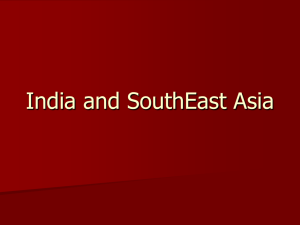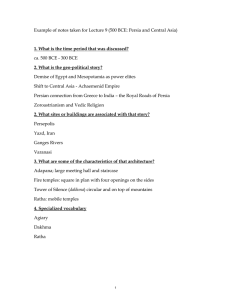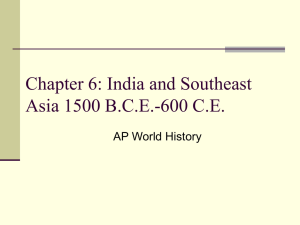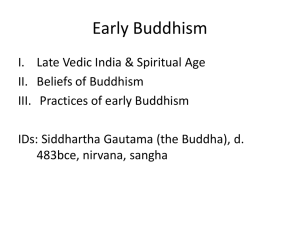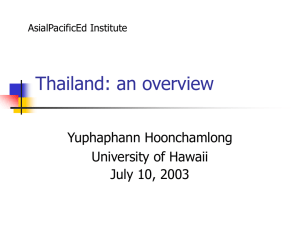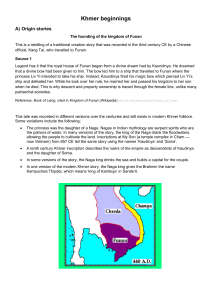SOUTH-EAST ASIA: FROM PREHISTORY TO 1450 CE
advertisement
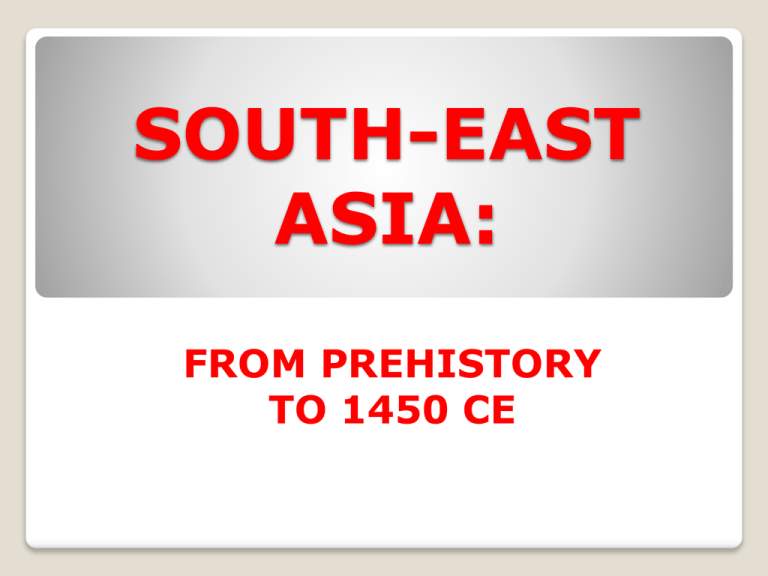
SOUTH-EAST ASIA: FROM PREHISTORY TO 1450 CE THE REGION THE LAND Peninsulas Indo-China Malay or Krat Archipelagos East Indies Sumatra, Borneo, Java, Celebes Philippines Luzon, Mindinao MOUNTAINS AND HILLS COASTAL PLAINS AND RIVER VALLEYS Region is product of volcanic activity, tectonic action Mountains run north-south; traversing difficult Plateaus between coasts and mountains cut by rivers Narrow coastal strips bordered by mountains, hills Isolated plateaus River valleys Constantly replenished by silt from rivers PHYSICAL GEOGRAPHY S.E. ASIAN PHYSICAL GEOGRAPHY BODIES OF WATER Straits Malacca Straits Sunda Straits Seas South China Sea WATER Rivers Red Mekong Irrawady Many streams, riverines Swamps and lakes MOVEMENT By seas, by water Only links between parts of the region THE SEAS THE MONSOONS ◦ Subject to Indian Ocean Monsoon Circuit Dry Wind: September to April Wet Wind: May to August ◦ Gentle Monsoon Flooding Excess water creates problems Irrigation necessary CLIMATES & FARMING ◦ Tropical, Subtropical lowlands Land: tends towards aguaculture Islands: plantation agriculture Jungles: slash-burn agriculture ◦ Plateaus, mountains Moderated climate Terrace farming common WINDS AND CLIMATES AGRICULTURE IN S.E. ASIA 7th Century BCE ◦ Hindu epic Ramayana Refers to the islands of Southeast Asia Lands of gold and grains Likely that some (few) Indian merchants had visited area th 5 Century BCE ◦ Internal Chinese migration, conquests ◦ Forced Migrations of local peoples into SE Asia Vietnamese, Mon-Khmers, Tibeto-Burmans, Thai 3RD Century BCE ◦ Ashoka sent Theravada Buddhist missionaries Mon peoples of Burma Mon exchanges with India: Hinduism, Buddhism, ideas, goods 334 BCE ◦ Chinese absorb Yueh (Vietnamese) state in Yangzte River; ◦ Chinese attempt to Sinicize elites, elite culture 2nd Century BCE ◦ 208 BCE: State of Nam Viet arose in Red River Select Chinese rulers, elites who adopt Vietnamese customs ◦ India, China begin to trade through SE Asia OUTSIDE CONTACTS Social ◦ Society stratified Towns ruled by elders, councils Elite culture Urban, rural quite distinct Extensive peasant class Autonomous villages Religion Gender ◦ Animistic, placation of spirits ◦ Ancestor worship critical in placation of spirits ◦ Shaman have great influence ◦ ◦ ◦ ◦ Descent traced through both males, females Women could rule states, own land Village elders include women Women run market places, businesses SOUTHEAST ASIAN SOCIETY Funan’s Origins ◦ Ethnically related to Mon-Khmer ◦ Chinese envoys K'ang T'ai and Chu Ying The state of Funan was established In the first century C.E. By an Indian Brahmin named Kaundinya ◦ Myth Concerning the Rise of Funan Indian Brahmin has dream to sail to Funan Shiva gave him a magic bow and arrow Kaundinya arrives at Funan: naked queen, followers attack boat Golden Arrow saves the day, Kaundinya clothes naked queen Marries the queen, becomes king, establishes Indian style Dynasty History ◦ Funan reached its greatest extent in the early third century C.E. Southern Vietnam, Cambodia, central Thailand Northern Malaysia (Kat Peninsula) Southern Burma ◦ It extended as far south as Malaysia and as far west as Burma ◦ Diplomatic missions sent to India and China ◦ Collapsed under pressure from Chenla in 6th century BCE FUNAN Structure of States in SE Asia Devaraja Cult Model created by Funan Adopted by Chenla, Khmer, Champa Srivijaya, Javanese ◦ Indian notion of divine ruler ◦ Incarnation of Shiva (could also be Vishnu) ◦ ◦ ◦ Ceremony overseen by Brahmins Population worships as god Symbolized by lingam Pillar representing strength of ruler Blended with local animism Buddhist Adaptation ◦ Rulers become bodhisatva ◦ Delay nirvana to help subjects DEVARAJA: GOD-KING State ◦ ◦ ◦ ◦ ◦ Quasi-feudal pattern with princes, aristocrats Large naval, merchant fleet; bureaucracy System of mercantilism, commercial monopolies Effectively a tribute empire Left local customs and identities intact Funanese Culture ◦ A mixture of native beliefs, Indian ideas. Southeast Asian believed the cobra to be sacred Idea of Indian naga (celestial serpent) used Practiced animism, ancestor worship ◦ Heavily influenced by Indian culture Employed Indians for state administration purposes ◦ Brahmins oversaw religion, religious ritual at court ◦ Kshatriyas dominated the aristocracy, royalty, military Sanskrit was the language at the court Religious doctrines Syncretism was strong Hinduism venerated Shiva but rarely Brahma or Vishnu Buddhism was Theravada but alternated with Mahayana STRUCTURE OF SOCIETY Southeast Asia's first great economy ◦ Funan was rich because of trade and agriculture ◦ Trade in spices, silver, gold, pearls, scented woods ◦ Funan grew massive surpluses of rice ◦ Funanese economy depended on rice surpluses ◦ Maritime trade also extremely important role ◦ At Funan’s main port, Oc Eo, were found Roman and Greek artifacts (glass, coins) Persian and Indian fabrics, cottons, manufactured goods Funanese Demography ◦ Population concentrated mainly along the Mekong River ◦ Towns, villages concentrated on coast, rivers ◦ Natural region for fishing and rice cultivation ◦ Extensive inland irrigation system ◦ Lowlands: Mon-Khmer peoples ◦ Highlands, Hills: Negritos ECONOMY & DEMOGRAPHY Jayavarman II (reigned AD 802 to 850) ◦ Lived as prince at the court of Sailendra dynasty in Java ◦ Influenced by refined art and culture of Javan Sailendra ◦ Adoption of the concept of divine Deva-Raja (God-King) Rulers deified as Shiva Lingam pillars displayed throughout state Late in the 8th and early in the 9th century ◦ Srivijaya launched naval raid against Indochina ◦ Invasion against the modern day Cambodia ◦ Jayavarman was a Srivijayan puppet ruler In 802 ◦ Recognized as the Deva-raja ◦ Declared independence FOUNDING THE KHMER EMPIRE KHMER EMPIRE Building Capital Cities ◦ ◦ ◦ ◦ No large cities to serve as capital Each new ruler added on to older capitals Many new rulers simply built new capitals Capitals were to impress people of rulers’ power Began extensive building projects Wealth gained through trade and agriculture made possible Indravarman I Reigned A.D. 877 - 889 ◦ Expanded kingdom without wars ◦ Followed by son Yasovarman I (reigned A.D. 889 - c. 910) ◦ Established a new capital, Yasodharapura (First city of Angkor) Jayavarman V From A.D. 968 to c. 1001 ◦ His rule was a largely peaceful period ◦ Marked by prosperity and cultural flowering ◦ Established a new capital near Yashodharapura, Jayenanagari ◦ At court lived philosophers, scholars and artists. ◦ New temples were also established including first of Angkor Wat NEW CAPITAL CITIES Hinduism ◦ Arrived with Indians ◦ Devotion to Shiva (Shaivism) ◦ Lesser devotion to Vishnu (Vaishnavism) ◦ Came devoid of castes Brahmins: religious advisors Kshatriyas were rulers, military Only in Bali did castes take ◦ Brought science, literature, art Cosmology Epic Poetry Puranas Buddhism ◦ ◦ ◦ ◦ ◦ Arrived from India as Mahayana Arrived from Ceylon as Theravada Bitter rivalry between two branches Only began to spread after 1200 CE in area Eventually Theravada became dominant HINDUISM AND BUDDHISM Similar to Tibetan Buddhism ◦ Mahayana Buddhism ◦ Blended with local animistic traditions Goal ◦ Attain bodhisatva status in this life ◦ Special means, practices accelerate nirvana Tantric Rites (Esoteric) ◦ The body mind is in a very subtle state ◦ Change the body mind During sex, death, meditation, dreaming Yoga, activities help achieve desired state ◦ Advanced practitioners transform the mind stream ◦ Achieve nirvana through these practices Arose in India through Hindu contacts ◦ Spread to Southeast Asia ◦ Srivijaya was one of the centers VAJRAYANA BUDDHISM ANGKOR WAT THE TEMPLE DISTRICT ANGKOR THOM Mongols disrupt East Asia ◦ Conquer China, Vietnam, Burma and disrupt trade ◦ Attempt to Invade Borneo and Java ◦ Khmer paid tribute to Mongols Rise of Thai ◦ ◦ ◦ ◦ ◦ ◦ Mongols conquer Nan Chao, Thai state in Sichuan China Thai peoples moved into Indo-China Settled in central peninsula Rebelled against Khmer Established Thai state Thai state eventually overran most of Khmer Empire Spread of Theravadan Buddhism changes Khmer state Costly construction projects bankrupted the state Dynastic civil wars weakened state Decline of Khmer Empire Burma (or Myanmar) ◦ Oldest ethnic group is Mon or Pyu. ◦ Burman people migrated from China-Tibet border c. 800 CE Into the valley of the Ayeyarwady Now form the governing majority. Paleolithic Life ◦ Artifacts suggests rice growing settlements c. 500 BCE ◦ Trade with Qin, Han Dynasties of China c. 200 BCE The Pyu ◦ ◦ ◦ ◦ ◦ ◦ ◦ ◦ Arrived in Burma in the 1st century BC Established 18 city-state kingdoms Part of an overland trade route from China to India War was virtually unknown Disputes solved through duels by champions or building competitions Wore silk cotton instead of actual silk so did not have to kill silk worms Crime was punished by whippings and jails were unknown, Pacticed Theravada Buddhism, ◦ Children educated as novices in temples from age of 7 until 20 ◦ BURMA (MYANMAR): PYU Mon kingdom of Dvaravati I ◦ Expanded in the lower Chao Phraya valley in present day Thailand ◦ Khmer forced Mon into modern Burma ◦ Oral tradition: Buddhism arrived via sea 3rd century BCE Adopted Indian culture ◦ ◦ ◦ ◦ Burmans arrive 8th Century CE ◦ ◦ ◦ ◦ ◦ ◦ Devaraja Concept Sanskrit Theravada Buddhism and are thought to have founded kingdoms I Indians probably founded Thaton in the 6th or 7th century and Pegu n 825 Founded Pagan First way of migrations from Tibet and China Unified all of Burma in early 11th century Expanded to borders of Khmer Empire Kings fell under control of Sangha brotherhood of monks Mongols invade and capture entire kingdom ending Pagan Dynasty Post-Mongols ◦ Burma divided into numerous states, constantly warring on one another ◦ Never able to recover as Thai Shan people migrated through region MYANMAR: MON & PAGAN An ancient Malay kingdom ◦ On the island of Sumatra ◦ Influenced Malay Straits & East Indies Archipelago Records ◦ Rare – usually Chinese ◦ Earliest proof of its existence from the 7th century A Chinese monk, I-Tsing Wrote that he visited Srivijaya in 671 ◦ Kedukan Bukit Inscription dated 683 ◦ Ceased to exist between 1200/1300 In Sanskrit ◦ Sri means "shining" or "radiant“ ◦ Vijaya means "victory" or "excellence" SRIVIJAYA Little evidence of Srivijaya remains According to the Kedukan Bukit Inscription ◦ Empire was founded by Dapunta Hyang Sri Jayanasa ◦ He led 20,000 troops, 200 warships ◦ To conquer Palembang, Jambi, and Bengkulu (Sumatra) Maritime Tribute Empire ◦ Had few resources, arable lands ◦ A thalassocracy based on sea power ◦ Wealth from trade, taxes on trade Palembang capital on Sumatra ◦ Administered directly by the ruler ◦ Hinterland Remained under local datus or chiefs Organized into a network of allegiance FORMATION & GROWTH Srivijaya ◦ Relied on fleet and force to run its empire ◦ Demanded tribute from semi-autonomous states By end of the 7th century ◦ ◦ ◦ ◦ ◦ Ruled coasts of Sumatra Parts of Eastern Java Coasts of Malaya Dominated Kat Peninsula on all sides Western Coasts of Borneo Rivalry with Chenla and Champa ◦ Srivijaya launched naval raids of coasts ◦ Installed rulers in Chenla, defeats Champa ◦ Founder of Khmer Empire severed link in same century By 12th Century ◦ Kingdom now ruled parts of Ceylon ◦ Sulawesi (Celebes) the Moluccas ◦ Sulu Archipelago and Visayas islands 7TH – 12th CENTURY Controlled ◦ Both the spice route traffic ◦ And local trade, charging tolls on passing ships ◦ Could turn to piracy when all else failed Served as an entrepôt ◦ For Chinese, Malay, and Indian markets ◦ Envoys travelled to and from China frequently Golden Age in 9th and 10th centuries CE ◦ Around decline of Tang in China ◦ Came to dominate trade in area ◦ Traded heavily with Song China Buddhist Centre ◦ Buddhist libraries and monks ◦ Centre visited by Indians, Chinese TRADE AND COMMERCE Java as Rival to Sumatra ◦ ◦ ◦ ◦ Java has few ports but large amounts of rich farm land States in Java tended to be small but heavily populated Javanese states defied Srivijavan control of the area Agricultural states produced large surpluses of crops Rice Paddy culture ◦ Requires extensive work on drainage, canals, terracing ◦ Dynastic states mobilized labor of large populations Sailendra power centered on the Kedu Plain (South Java) ◦ ◦ ◦ ◦ An area where paddy field or sawah cultivation flourished Location secure from sea-borne Srivijayan raids Used of symbolic power associated with Hinduism, Buddhism An Indianized court Maintained close alliance with Srivijaya ◦ Married their sons, daughters into Srivijaya ◦ Later when ousted from Java, became rulers in Srivijaya JAVA: SALIENDRA Cholan Empire in Southern India ◦ Srivijaya tries to conquer Ceylon, annoys Cholan Empire ◦ In 1025 Chola king conquered Kedah, occupied other areas ◦ Cholas continued a series of raids and conquests ◦ Chola invasion weakened the Srivijayan hegemony ◦ Enabled the formation of regional kingdoms ◦ Based on intensive agriculture rather than trade Majapahit ◦ On Java Replaces Matarem and Saliendras ◦ In 1288 conquered Palembang, Jambi, much of Srivijaya In 1293, Majapahit ruled much of Sumatra In 1347 Majapahit Prince given responsibilities over Sumatra ◦ Rebellion in 1377 Was squashed by Majapahit Left area of southern Sumatra in chaos and desolation Rivers silted up – cut off trade Arrival of Islam to Acheh and Malaccan straits changed society DECLINE Kedu Plain ◦ Dynasty asVajrayana Buddhist ◦ Built shrines and temples Built Borobudur temple complex Largest Buddhist structure in world BOROBUDUR Mongol Invasion Yuan Dynasty invades, destroys Matarem Raden Wijaya allies with Mongols, tricks them into leaving Establishes new capital at Majapahit Succeeding princes, princesses strengthen state Attacks Srivijaya; expels them from Western Java The State Decentralized, semi-autonomous state Large areas connect by trade, ritual Buddhism, Shaivism, Vaishnavism King was regarded as incarnation Sophisticated court Refined taste in art and literature Complex system of religious rituals. The Nagarakertagama written in 1365 Great Javanese epic Tells of the rise of Majapahit JAVA: MATAREM & MAJAPAHIT MAJAPAHIT The kingdom of Champa ◦ ◦ ◦ ◦ Controlled southern and central Vietnam Consisted of 5 Provinces, numerous capitals People were Malayo-Polynesian Little arable land – relied on piracy, trade Outside Influences ◦ China, India, Khmer Empire ◦ Initially tied to Chinese cultural, religious traditions 4th Century: conquered Funanese lands ◦ ◦ ◦ ◦ Infusion of Mon-Khmer culture, institutions Predominance of Hinduism (Shaivism) as state religion Mahayana Buddhism important later in history Sanskrit was adopted as a scholarly language 7th-10th Centuries ◦ Controlled spice trade between Indonesia and China ◦ Much preferred by Arab merchants over Srivijaya ◦ Constant rivalry between Khmer, Champa Decline 11th to 19th Centuries ◦ Mongols conquered in 13th century ◦ Decline due to rise to power of Nam Viet CHAMPA Nan Chao ◦ ◦ ◦ ◦ ◦ ◦ ◦ Thai state in Sichuan Ethnic Thai are Sino-Tibetan Powerful military: able to resist Chinese Controlled trade routes between India, China Pressure from Mongols forces a migration State destroyed by Mongols in late 13th century Large migration through Burma into Khmer Empire Sukhothai becomes the Kingdom of Siam ◦ First Thai states in Indo-China Established 1238 Three principalities which unite in 1287 Expands into the Menam river valley Siam is the real destroyer of Khmer State ◦ Adopt Mon-Khmer civilization Creates Siamese alphabet from Mon-Khmer Devaraja Theravadan Buddhism SUKHOTHAI: SIAM Conversion to Islam was slow and quiet ◦ ◦ ◦ Ruling elite converted in cities Rural residents retained their traditions Islam was not an exclusive faith ◦ In southeast Asia, people practiced many beliefs Sufis Appealed to a large public in these countries Aided conversation by toleration, understanding Melaka was first powerful Islamic state ◦ ◦ ◦ On Straits of Malucca Power based on controlling trade Destroyed by Portuguese ARRIVAL OF ISLAM
![Cambodian New Year - Rotha Chao [[.efolio.]]](http://s2.studylib.net/store/data/005298862_1-07ad9f61287c09b0b20401422ff2087a-300x300.png)
